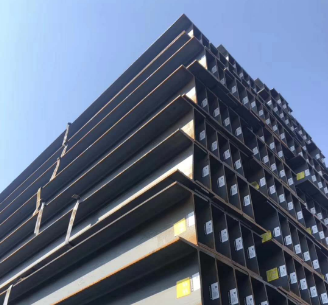Projects
The Significance of H-Shaped Steel to Construction
H-shaped steel is a new type of economical construction steel. H-shaped steel has an economical and reasonable cross-section shape and good mechanical properties.

During the process of rolling, the extension of each point on the cross-section is relatively uniform and the internal stress is small. Compared with ordinary I-beam steel, it has the advantages of large section modulus, light weight and metal saving; and because the inner and outer sides of the legs are parallel and the leg ends are at right angles, they can be assembled into components, which can save 25% of the welding and riveting workload. It is often used in large buildings that require large interception capacity and good cross-sectional stability (such as factories, high-rise buildings, etc.), as well as bridges, ships, lifting and transportation machinery, equipment foundations, brackets, foundation piles, etc.
Its characteristics are as follows: wide flange, large lateral stiffness; strong bending resistance, about 5%-10% than I-beam; the two surfaces of the flange are parallel to each other, making connection, processing and installation easy; compared with welded I-beam, low cost, high precision, small residual stress, there is no need for expensive welding materials and weld detection, saving about 30% of steel structure production costs; under the same cross-sectional load, hot-rolled H steel structures are 15-20% lighter than traditional steel structures.
Compared with the concrete structure, the hot-rolled H steel structure can increase the use area by 6%, while the structure’s dead weight is reduced by 20% to 30%, reducing the internal stress of the structural design; H-shaped steel can be processed into T-shaped steel, and honeycomb beams can be combined to form various cross-sectional forms greatly meet engineering design and production needs.
Nowadays, all walks of life are looking for ways to improve. People hope to get twice the result with half the effort in their profession through research and experimentation. However, in many cases, it is not something that can be changed by humans. It requires innovation in the tools, materials or some technical means used, such as laser processing. After completing this process, the emergence of H-shaped steel appeared under such a situation. So what advantages does it have over ordinary I-shaped steel?
In fact, from a definition point of view, H-shaped steel is also a special case of I-beam, so H-shaped steel has another name called parallel flange I-beam. However, because the flanges of H-shaped steel are parallel and equal in width, it is better than other types of I-beam. I-beams perform better under pressure, so H-beams are used to replace I-beams in some buildings and metal structures.
In addition, if the center line of the flange is taken as the axis, it is called the strong axis, and the straight line vertical to the flange with the center point of the web is the weak axis. According to the pressure requirements of different building structures, the degree of bending of H-shaped steel under stress also has a big difference. In view of this difference, people are more optimistic about H-beams, and H-beams are more convenient and safer in terms of transportation and handling. At the same time, it is more efficient in splicing and welding and labor saving, which are the reasons why H-shaped steel replaces ordinary I-beam. Thus, more and more people choose to use laser equipment to handle the materials, ensuing its quality.
If you find a building on the street that had a frame soon after it was demolished and the construction speed was very fast, then it is very likely that H-shaped steel was used in this project, and the use of H-shaped steel has brought great benefits to the builders and construction workers. With many conveniences and benefits, H-shaped steel has become the “superstar” in the construction industry.



































